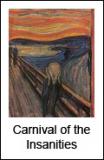The Fence
Around a certain country there were a series of hazards which, over the course of time, had been understood to be dangerous. There were cliffs, active and unstable volcanoes, crags with falling rocks, areas of parched desert prone to flash flood, streams filled with crocodiles, and dense jungles patrolled by carnivores. The people of the country knew the dangers, but periodically someone would be attacked by a shark or eaten by a grue.
The people began erecting fences all over and around this land, and posting signs on the fences declaring the consequences for breeching them. In some areas, the fence was to keep the danger out, while in others the people themselves were the danger.
Sometimes the fences didn't meet correctly on their edges, or raised other quality concerns. The people wisely appointed specialists to represent them in regard to the fences. There were Fence-Builders to make new fences as new conditions arose, and Fence-Keepers charged with inspecting the fences. The Fence-Keepers carried tools which they called Restraint and Ethics, which allowed them to work around and even outside the perimeter fence with minimal risk to themselves and others. Some of the Fence-Keepers came to be appointed Supreme Fence-Keepers. The Supreme Fence-Keepers soon declared that they had the final say in how the fence should be kept.
Now, most people knew where the dangers were, and where the perimeter fence was, but there were areas of danger inside the fence, and areas of safety outside it; a constant debate took place among the people of the land as to where the fences should be made tall or short, or where the perimeter should be moved out to enclose new areas thought now to be safe for a modern, well-educated people, or where it should be moved in to protect against areas now known to contain danger.
Some of the dangerous areas, such as the shark-infested waters of the ocean, had an allure for the people. They were willing to brave the danger, and over time the fence moved closer to the beach, then into the water, and into deeper water, until fully submerged. Signs were posted, but no one was quite sure where the fence actually was, for the Fence-Keepers kept moving it to satisfy the needs of their own technical requirements, which were sometimes not related to the primary mission of separating the people from danger. The fence was underwater and invisible in these areas, but the Fence-Keepers went right on arguing among themselves and changing its location to meet their own arcane criteria. The people decided where they could go in the water, sharks or not.
Special soundproof fences were built to keep the people from hearing one another speak an offense, which had the unforeseen side effect that the people could not hear each other at all.
Gradually, the Builders built more fences than the Keepers could keep, even with their advanced Restraint and finely-tuned Ethics. There were fences on the sidewalks, fences in the street, fences around churches and in the schools. Wherever the people went, the Builders had put a fence. The Keepers, Ethics and Restraint in hand, maintained them as best they could. With so many fences, it became difficult to tell which ones should be given priority; the Keepers just waited for the people to complain, and then argued among themselves a while.
Many of the Supreme Fence-Keepers had realized that they needed their Ethics much more than their Restraint. They set aside their Restraint, and began ordering that some fences be moved, torn down, or altered. They began taking the old fences, since there were so many that were used so little, and with judicious use of Ethics made entirely new fences. The people were just as happy with the Fence-Keepers' fences as with the Builders', even when the Keepers began using imported fence parts. To keep the people trusting the fences, the Builders allowed the Keepers to build, and then went back to counting.
Sphere: Related Content
 This amount of arrogance, the sheer impardonable pretension, is bound to be popular.
This amount of arrogance, the sheer impardonable pretension, is bound to be popular.










No comments:
Post a Comment